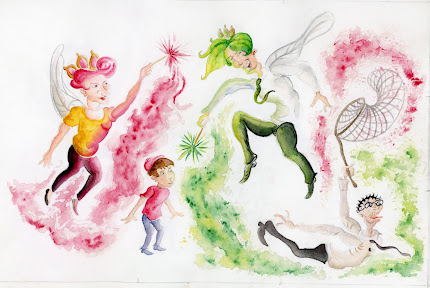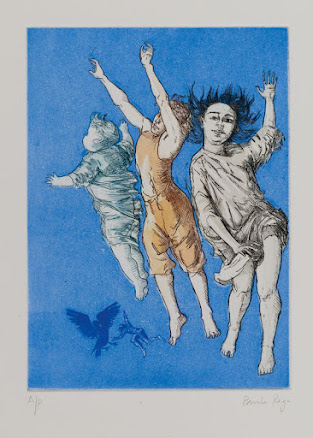Essentials
Friday, 25 November 2022
They're Back..........Maybe?
Sunday, 7 August 2022
Once upon a Timmy Progress
I would then produce further studies to see what poses to put the characters. I would also experiment with tones and textures, trying to add highlights and details with the different brushstrokes. When I had sketched out the roughs and final layout drawing, I would experiment with the watercolour. As soon as the final illustration was done, I would take it to Photoshop to fix the colours and lighting.
Thursday, 9 June 2022
Paula Rego Tribute
Tuesday, 8 March 2022
Top 10 Female Artists
Well, it's been a while since I've made a fresh top 10 list, hasn't it. Sorry if it's been so long; but it's hard to compete with the number of lists the Internet has to offer. So to get into the habit of posting more on this blog, I'm going to use for its original intention, to analyse the techniques of paintings. In honour of International Women's Day, I've decided to list the women artists that I admire. As I'm all about gender diversity, I believe those female artists can be just influential, aspiring and talented as male ones. This list will cover artists who've worked in illustration, animation and fine art, once again, this is based on the artists that I look up to the most, so its all subjective.
10. Marcia Williams
I'm always interested to see what Williams has to offer, there's just a charm to her simplified versions; that actually formed my own sense of humour. It's always fun to re-visit her from time to time.
9. Sandy Nightingale
Here's another artist you might not be familiar with, but I've discovered through second-hand books. Herearlier works adapt poems and fairy tales for young readers, but what makes her versions effective is her distinctive character design. Which is done with such finesse and detail that convey strong expressions. But her work managed to get much more colourful and expressive over the years. Her collaboration with writer Sandi Toksvig has such quirky mannerisms and smooth tones and values that I aim to use a similar approach with my own artwork. Nightingale is an example of an artist that needs more attention than she gets. I can imagine you saw her illustrations as a child, and again as an adult.
8. Susan Young
You may not know her by name, but if you've listened to a lot of music in the 90s, you might have seen her animations. I learnt of her when she actually made a lecture at my university years ago. She has worked with the likes of David Bryne and did advertisements for Levis. What struck me about her animations was the colour and fluidity. The movements are both expressive and believable. Young's use of effects and metamorphosis display such colour to these beautifully energetic sequences.
Although she did not do anything during the 2000s, she was able to fall back on her studies in psychology. She has been able to return to filmmaking by representing the human psyche through autoethnographic effects. If you wish to explore her works for yourself, check out her website and Vimeo for some truly enigmatic sequences.
7. Pauline Baynes
I believe the fantasy genre today owes a lot to Baynes. Her ink and colour plate illustrations for J.R.R Tolkien and C.S Lewis (respectively) have managed to bring Middle Earth and Narnia to life. Her character designs convey such believable charismatic posing, while the backgrounds make you feel like you're stepping into the page. She was able to work with a variety of colour palettes, from simple to detailed. Baynes could also evoke the spirit of medieval miniatures, making the fantasy worlds immersive.
6. Rene Cloke
Although I was born and raised a millennial, I was still able to discover the illustrators from before my time. Rene Cloke is mainly known for her artwork for children's literature and greetings cards. Her depictions of mystical fantasy beings like fairies and elves are so full of whimsy. There's such a fluidity in her character design and brushstrokes that helped formed the building blocks of my own individual style and sense of world-building. Both her children and animal characters are drawn in a cute and quaint fashion, that manages to stay charming after all these years. Whether it be her illustrations for Enid Blyton or tales from the public domain, Cloke could deliver her magic touch to each story in her own fanatical way. And although some of her works may be products of her time, generations of children are likely to be enchanted by her whimsical creatures,
5. Faith Jaques
From the very first time I saw the works of Faith Jaques, I knew there was something unique and special about her. There's such a quint charm to Jaque's illustrations that would resonate with me, in a way they made me take books seriously; as a medium and an art form. When I was trying to form my own style, I looked to her for inspiration, there's something so distinctive with how she drew characters and the attention to detail to make them pop out. Whatever the size of her artwork, you could feel the mark makings in every aspect of it. The characters display such gestural posing and distinctive facial features that encouraged me to explore spot illustration. No matter how long the material, or how old I get, the illustrations of Faith Jaques still hold up in my book.
4. Hilda Boswell
Yet another illustrator from before my time, just like Rene Cloke; Hilda Boswell's book illustrations have such a whimsical charm to them. Though she may not be as big a household name as Kate Greenaway, I believe she deserves to be held in much higher regard. When I discovered the books she illustrated at a very young age, I remember being enchanted by her use of luscious colour and expressive draftsmanship. This was an artist who could work with a range of different media, from her tonal application to her flat opaque colours. Boswell's illustration captured such emotion and body language that make the characters come alive. There's a beauty to her expressive characters and colours that embodies the last century, but it doesn't feel overly saccharine. Looking at a Boswell illustration is like an illustration paradise. I could go on about how much of an impact she left on me, but I'll just say she is definitely worth looking into if you want to go into children's book illustration.
3. Frida Kahlo
It seems typical of me to include the most renowned female/Latin artist who ever lived, and that I'm half
Latino myself. But there's something so fascinating about the life and works of Magdelena Carman Fraida Kahlo y Calderon. At face value, the fact that an artist's body of work mainly depicts themselves may seem egotistical. But Kahlo's self-portraits say a lot about her pain and personal experiences. Like a lot of Mexican folk art, Kahlo's paintings are very surreal and take inspiration from Aztec mythology. Her use of vibrant colours and tonal application give her pictures their own language. These surreal depictions of herself reflect her personal growth and resilience, you can tell she used art as therapy. People have given many interpretations of these surreal elements, reading them as symbols for good reason. She remains an influence on female artists and Mexican culture as a whole.2. Georgia O'Keeffe
When it comes to colour and tonal values, its Georgia O'Keeffe that planted the seeds for my approach to such. This is a painter who needs no introduction. O'Keeffe depicted both natural forms and architectural buildings on a large scale. Each floral painting showcases a variety of tones, she would capture the essence of her subject, taking sections of it and turning them abstract. People have theorised that her paintings contain innuendo to a woman's genitalia, but I for one see them as natural exploration. Whatever way you read into her work and how you interpret it, you can still admire the strokes that went into such an impression.
1. Paula Rego
While I do understand modern art, I can't say I'm personally a fan of it. But one artist from the modern era that's using the medium to convey a narrative, and one I still admire to this day is Portuguese artist Maria Paula Figueiroa Rego. Being half Portuguese myself, Paula was the first artist I discovered of that nationality. She was also my earliest exposure to modern art in general. This is an artist whose work has evolved so much, going through many changes. Paula has worked in a variety of media, She has taken inspiration from folk tales and interpreted them in an avant-garde fashion. But she has also reflected themes that are personal to her, such as feminism. She captures raw human emotion through body language and facial features. She's able to exaggerate reality that she even features models that she herself constructed. Her works can tell a story, whether it be through mannerisms or symbolism and I hope more people will look back on the legacy she's left on the Portuguese art scene.
And those are some of my favourite female artists, they're many other amazing artists I could have given an honourable mention to. But I'll go into those another day. As always, tell me if you agree with my choices or not. And discuss your favourite female artist as well. Now if you excuse me, I got to think of a better way to close out these blog posts.
Tuesday, 4 January 2022
What Cow and Chicken Means To Me







































